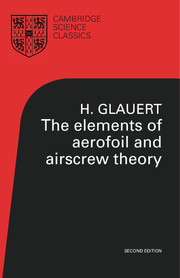Book contents
- Frontmatter
- PREFACE
- PREFACE TO SECOND EDITION
- Contents
- REFERENCES
- Chap. I Introduction
- Chap. II Bernoulli's Equation
- Chap. III The Stream Function
- Chap. IV Circulation and Vorticity
- Chap. V The Velocity Potential and the Potential Function
- Chap. VI The Transformation of a Circle into an Aerofoil
- Chap. VII The Aerofoil in Two Dimensions
- Chap. VIII Viscosity and Drag
- Chap. IX The Basis of Aerofoil Theory
- Chap. X The Aerofoil in Three Dimensions
- Chap. XI The Monoplane Aerofoil
- Chap. XII The Flow round an Aerofoil
- Chap. XIII Biplane Aerofoils
- Chap. XIV Wind Tunnel Interference on Aerofoils
- Chap. XV The Airscrew: Momentum Theory
- Chap. XVI The Airscrew: Blade Element Theory
- Chap. XVII The Airscrew: Wind Tunnel Interference
- Appendix
- Bibliography
- Index
Chap. XIV - Wind Tunnel Interference on Aerofoils
Published online by Cambridge University Press: 01 June 2011
- Frontmatter
- PREFACE
- PREFACE TO SECOND EDITION
- Contents
- REFERENCES
- Chap. I Introduction
- Chap. II Bernoulli's Equation
- Chap. III The Stream Function
- Chap. IV Circulation and Vorticity
- Chap. V The Velocity Potential and the Potential Function
- Chap. VI The Transformation of a Circle into an Aerofoil
- Chap. VII The Aerofoil in Two Dimensions
- Chap. VIII Viscosity and Drag
- Chap. IX The Basis of Aerofoil Theory
- Chap. X The Aerofoil in Three Dimensions
- Chap. XI The Monoplane Aerofoil
- Chap. XII The Flow round an Aerofoil
- Chap. XIII Biplane Aerofoils
- Chap. XIV Wind Tunnel Interference on Aerofoils
- Chap. XV The Airscrew: Momentum Theory
- Chap. XVI The Airscrew: Blade Element Theory
- Chap. XVII The Airscrew: Wind Tunnel Interference
- Appendix
- Bibliography
- Index
Summary
The limited extent of the stream of air in a wind tunnel, whether of open or of closed working section, imposes certain restrictions on the flow past an aerofoil or other body under test, and the determination of the magnitude of this interference is of considerable importance, since it is found that certain corrections must be applied to the aerodynamic characteristics of an aerofoil tested in a wind tunnel before they are applicable to free air conditions. This interference correction is independent of and additional to any correction which may be necessary to allow for the change of scale from a model aerofoil to an actual aeroplane wing.
The theory of the interference has been developed by Prandtl in his second aerofoil paper by considering the conditions which must be satisfied at the boundary of the stream. The continental wind tunnels usually have an open working section and the condition of constant pressure must be satisfied at the boundary of the stream. British wind tunnels, on the other hand, have a closed working section of square or rectangular cross section, and the boundary condition takes the form that the component of the velocity normal to the tunnel walls must be zero. This boundary condition can be satisfied analytically by the introduction of a suitable series of images of the model, and the interference experienced by the model is the induced velocity corresponding to the vortex systems of these images.
- Type
- Chapter
- Information
- The Elements of Aerofoil and Airscrew Theory , pp. 189 - 198Publisher: Cambridge University PressPrint publication year: 1983



